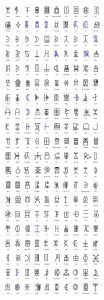Nsibidi is a system of symbols or proto-writing that originated among the Ejagham people in southeastern Nigeria. It is one of the oldest forms of writing in Africa, dating back to at least 400 AD, and possibly earlier. Nsibidi is not tied to any one spoken language, but rather conveys abstract concepts, actions or things that can be understood by speakers of different languages. Nsibidi was used for various purposes, such as communication, decoration, ritual, art and secret societies.
The Origins and Development of Nsibidi
The exact origins of nsibidi are unknown, but some scholars suggest that it may have evolved from ancient rock art or body scarification. The earliest archaeological evidence of nsibidi comes from terracotta vessels, headrests and figurines from the Calabar region of Nigeria, dated to roughly the 5th to 15th centuries. These artifacts show symbols that are comparable to nsibidi, suggesting a long history of use and development.
Nsibidi was mainly associated with the Ekpe leopard society, a secret society that wielded political and judicial power among the Ekoi, Efik, Ibibio, Igbo and other peoples in the Cross River area. The members of Ekpe used nsibidi to communicate messages, record laws, keep accounts and mark their territory.
They also used nsibidi to decorate their clothing, calabashes, metals, leaves and tattoos. Nsibidi was considered a sacred and powerful writing system that only initiated members could learn and use.
However, nsibidi was not exclusively used by Ekpe or men. There was also a public and more decorative version of nsibidi that could be used by women and non-members. This version was used for love letters, proverbs, riddles, stories and other forms of entertainment.
Some women also used nsibidi to mark their cloth wrappers or pottery with personal or clan symbols.
The Characteristics and Structure of Nsibidi
Nsibidi consists of several hundred symbols that can be classified as pictograms, ideograms or logograms. Pictograms are symbols that resemble the objects they represent, such as a snake, a bird or a house.
Ideograms are symbols that express abstract ideas or concepts, such as love, death or justice. Logograms are symbols that stand for words or phrases in a specific language, such as names, titles or greetings.
Nsibidi symbols can be combined to form complex meanings or sentences. For example, a symbol of a man with a hat can mean “chief”, while adding another symbol of a line can mean “great chief”. Similarly, a symbol of a heart can mean “love”, while adding another symbol of a knife can mean “heartache”. Some nsibidi symbols can also be modified by adding dots, lines or circles to indicate tense, mood or number.
Nsibidi symbols can be written or drawn in various ways, depending on the medium and the context. They can be linear or curved, simple or elaborate, monochrome or colorful. They can be inscribed on wood, metal, clay, cloth or skin. They can also be arranged in different patterns or orientations, such as horizontal, vertical, circular or spiral.
The Influence and Legacy of Nsibidi
Nsibidi was not only used in Nigeria but also spread to other parts of West Africa and beyond through trade and migration. Some nsibidi symbols were adopted by other cultures and languages, such as the Igala , the Yoruba , the Fon and the Ewe.
Nsibidi also influenced some forms of writing in the Americas , such as the anaforuana in Cuba and the veve in Haiti , which were brought by enslaved Africans from the Cross River region.
Nsibidi survived the colonial era of Nigerian history , despite the suppression of indigenous cultures and languages by the British . However, its use declined significantly due to the introduction of Western education , Christianity and Arabic scripts . Today , nsibidi is mostly preserved by elders , scholars and artists who seek to revive and promote this ancient writing system .
Some contemporary examples of nsibidi include the Ukara cloth , which is still woven and dyed by the Arochukwu people in Abia state , and the Neo-Nsibidi , which is a modern adaptation of nsibidi by Nigerian graphic designers , musicians and filmmakers .
Nsibidi also inspired the Wakandan writing system shown in the 2018 Marvel Cinematic Universe film Black Panther².
The production designer Hannah Beachler consulted with experts on African writing systems and chose nsibidi as the basis for the fictional language of Wakanda , a technologically advanced African nation.
She modified some nsibidi symbols and created new ones to fit the aesthetic and culture of the film .
Nsibidi can be seen on various props, costumes, sets and graphics in the film , adding a layer of authenticity and depth to the story .
Nsibidi is a fascinating and unique writing system that reflects the rich history , culture and diversity of Nigeria . It is a testament to the creativity and ingenuity of African peoples who developed their own ways of writing and communicating long before the arrival of Europeans . Nsibidi is also a source of inspiration and pride for Nigerians who seek to reclaim and celebrate their heritage and identity .
References
¹: Nsibidi – Wikipedia. https://en.wikipedia.org/wiki/Nsibidi
²: Black Panther: Wakanda Forever (2022) – IMDb. https://www.imdb.com/title/tt9114286/
³: A Look At Nsibidi: The Long Lost Nigerian Writing | The Guardian Nigeria News – Nigeria and World News — Guardian Life — The Guardian Nigeria News – Nigeria and World News. https://guardian.ng/life/a-look-at-nsibidi-the-long-lost-african-writing/
: Inscribing Meaning: Nsibidi / National Museum of African Art. https://africa.si.edu/exhibits/inscribing/nsibidi.html
: Nsìbìdì: An Indigenous Language of Communication in the … – Springer. https://link.springer.com/chapter/10.1007/978-981-19-2932-8_23


















